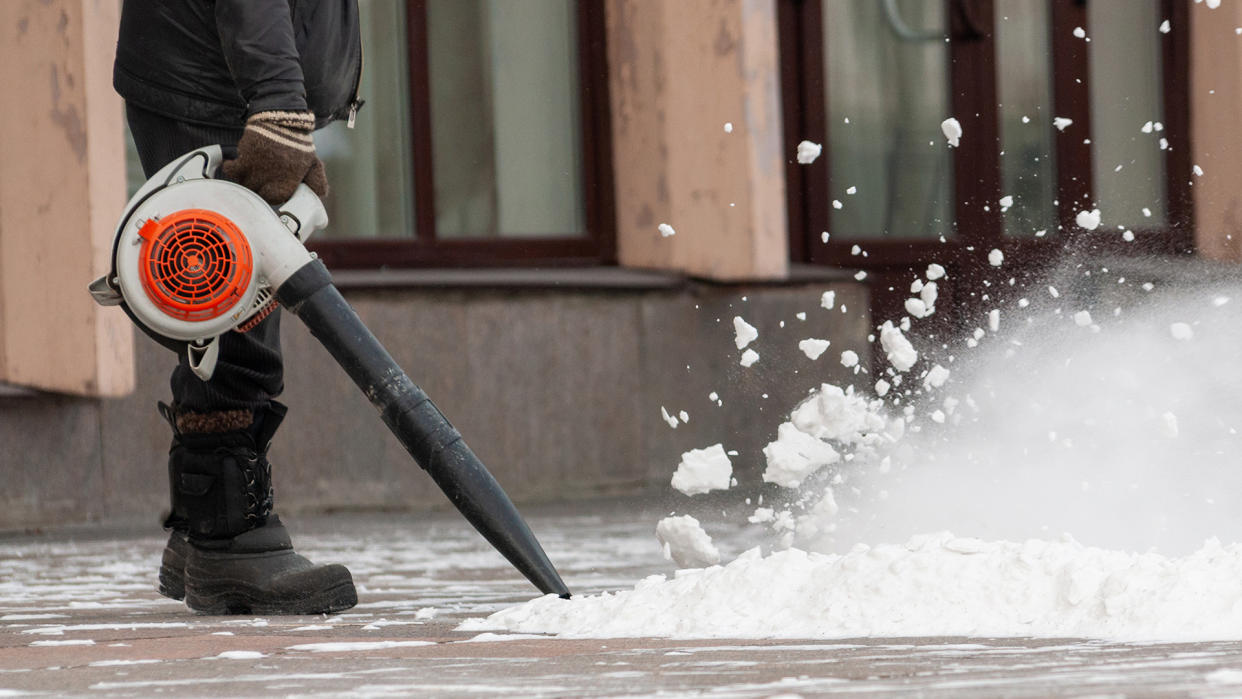Can you use a leaf blower for snow?

Can you use a leaf blower for snow? It might be a surprise to learn that your trusty fall yard tool can also help you out in these cold winter months, too.
A leaf blower can, in the right circumstances, and when used safely, be a valuable tool for clearing dry and powdery snow from areas around your property, and even your car. However, the key is safety.
Our guide to using a leaf blower for snow will take you through the kind of leaf blower you should be using, what safety precautions you need to take, and when to know if your leaf blower is not the right tool for the job. We’ve also spoken to a gardening expert to get their take on using a leaf blower in wintry conditions.
If you haven’t already got a leaf blower, or you’re looking for a new model that has more power, you’ll find top-rated models in our buyer’s guide to the best leaf blowers, from gas and electric models to lightweight or budget options.
Can you use a leaf blower for snow?
What the expert says...
Are there any other ways of getting rid of snow? “Shovelling snow is a relatively safe method of moving it,” says Jenkins. “However, this can take quite a lot of work if you have a large amount of snow. You can also melt snow by spreading some salt over the area. This only really works with low-pile snow, though.”
It’s perfectly possible to use a leaf blower to move snow from around your property. In fact, Consumer Reports recommends it as an ideal way of moving light snow from your doorstep and pathways in the winter months.
However, a leaf blower is not suitable for heavy snowfall. For that, you’re going to need one of the best snow blowers or a snow shovel. But if you have a couple of inches or so of snow to clear, there’s no reason why your trusty leaf blower can’t do the job just as well. For removing snow from places your shovel doesn’t work so well, such as porches, doorsteps, and vehicles, your leaf blower can be a great tool.
The ideal time to use your leaf blower is when the snow is still powdery. As temperatures climb after snowfall, the blanket of snow will become wetter, and your leaf blower will struggle to remove it. A leaf blower won’t have the power to tackle really deep snow either, so if you have any more than two or three inches of snowfall, use a snow blower or a shovel.
A backpack leaf blower is best suited to this kind of work. While a handheld leaf blower may help to remove a light coating of snow from small areas, such as windshields, or steps, a backpack leaf blower has the power to tackle a wider variety of spots.
A gas-powered leaf blower with 400 cubic feet per minute (CFM) should be enough to tackle most jobs. Anything less powerful than this, and you may as well be shoveling the snow away instead.
How to use a leaf blower for snow
For steps, driveways, porches, and small patches of ground:
Aim your leaf blower at an angle to the snow, just as you would with leaves.
Make sure you’re working with the wind, so you don’t have snow flying back on your cleared area, or into your leaf blower.
Sweep your leaf blower from side to side until the area is clear.
For clearing snow from cars:
Using the same angle as before and starting on one side of the car, blow the snow from the roof, down onto the hood or trunk.
Move to the other side and repeat.
Work your way down the windshield, hood, headlights, and front bumper.
Repeat at the back of the car, working your way down the rear windshield, trunk, taillights, and rear bumper.
Finish off by working around each tire.
Safety tips for using a leaf blower for snow
If you’re using a leaf blower to remove snow, make sure you regularly check the air filter for any snow and ice buildup. You should also keep a careful eye on the air-intake grid to make sure there’s no build-up there too.
Ideally, you should be using a gas-powered leaf blower, to avoid any danger of water getting into the machinery and giving you a shock. Remember - water and electricity do not mix. It can be very dangerous for you, not to mention that you run the risk of your leaf blower shorting out.
However, if you’re using an electric leaf blower instead, be sure to plug it into an outlet that has a ground-fault circuit interrupter. If you’re using a battery-powered cordless version, check that it’s water-resistant.
We also spoke to MyJobQuote gardening expert Fiona Jenkins, for her take on using a leaf blower for snow. Although she agrees it’s a convenient way of removing snow build-up, there are certain safety precautions to take, as well as making sure you’re well-prepared for the icy conditions.
“When clearing snow with a leaf blower, it’s important to gear up properly,” says Jenkins. “You need to wear proper shoes or boots with a good sole on them so that you don’t slip and fall and so that your feet don’t get wet or cold. You must also ensure that you are warm enough to tackle the job. Wear a warm jacket, gloves, and a head and face covering. ”
It’s also important to protect your eyes. Dirt, debris, and grit could all be hidden under the snow. “Eye protection is a good idea,” says Jenkins, “as the flying snow could come back at you.”
Making sure your setup is safe is also key to avoiding the risk of electrocution, according to Jenkins. “If your leaf blower is corded, you must ensure it is plugged into a safe outlet and avoid dragging the cord through any puddles.”